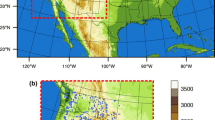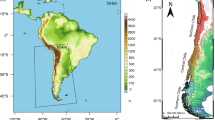Abstract
This study examines a scenario of future summer climate change for the Korean peninsula using a multi-nested regional climate system. The global-scale scenario from the ECHAM5, which has a 200 km grid, was downscaled to a 50 km grid over Asia using the National Centers for Environmental Prediction (NCEP) Regional Spectral Model (RSM). This allowed us to obtain large-scale forcing information for a one-way, double-nested Weather and Research Forecasting (WRF) model that consists of a 12 km grid over Korea and a 3 km grid near Seoul. As a pilot study prior to the multi-year simulation work the years 1995 and 2055 were selected for the present and future summers. This RSM-WRF multi-nested downscaling system was evaluated by examining a downscaled climatology in 1995 with the largescale forcing from the NCEP/Department of Energy (DOE) reanalysis. The changes in monsoonal flows over East Asia and the associated precipitation change scenario over Korea are highlighted. It is found that the RSM-WRF system is capable of reproducing large-scale features associated with the East-Asian summer monsoon (EASM) and its associated hydro-climate when it is nested by the NCEP/DOE reanalysis. The ECHAM5-based downscaled climate for the present (1995) summer is found to suffer from a weakening of the low-level jet and sub-tropical high when compared the reanalysis-based climate. Predicted changes in summer monsoon circulations between 1995 and 2055 include a strengthened subtropical high and an intensified mid-level trough. The resulting projected summer precipitation is doubled over much of South Korea, accompanied by a pronounced surface warming with a maximum of about 2 K. It is suggested that downscaling strategy of this study, with its cloud-resolving scale, makes it suitable for providing high-resolution meteorological data with which to derive hydrology or air pollution models.
Similar content being viewed by others
References
Byun, D. W., and K. L. Schere, 2006: Review of the governing equations, computational algorithms, and other components of the models-3 Community Multiscale Air Quality (CMAQ) modeling system. Appl. Mech. Rev., 59, 51–77.
Cha, D.-H., and D.-K. Lee, 2009: Reduction of systematic errors in regional climate simulations of the summer monsoon over East Asia and the western North Pacific by applying the spectral nudging technique, J. Geophys. Res, 114, D14108, doi:10.1029/2008JD011176.
Fu, C, S. Wang, Z. Xiong, W. J. Gutowski, D.-K. Lee, J. L. McGregor, Y. Sato, H. Kato, J.-W. Kim, and M.-S. Suh, 2005: Regional climate model intercomparison project for Asia. Bull. Amer. Meteor. Soc., 86, 257–266.
Giorgi, F., J. W. Hurrell, M. R. Marinucci, and M. Beniston, 1997: Elevation dependence of the surface climate change signal: A model study. J. Climate, 10, 288–296.
Ham, S.-R., S.-J. Park, C.-H. Bang, B.-J. Jung, and S.-Y. Hong, 2005: Intercomparison of the East-Asian summer monsoon on 11–18 July 2004, simulated by WRF, MM5, and RSM models. Atmosphere, 15, 91–99. (in Korean with English abstract)
Han, J., and J. Roads, 2004: US climate sensitivity simulated with the NCEP regional spectral model. Climatic Change, 62, 115–154.
Hong, S.-Y., and A. Leetmaa, 1999: An evaluation of the NCEP RSM for regional climate modeling. J. Climate, 12, 592–609.
__, H.-M. H. Juang, and D.-K. Lee, 1999: Evaluation of a regional spectral model for the East Asian monsoon case studies for July 1987 and 1988. J. Meteor. Soc. Japan, 77, 553–572.
Hurkmans, R., W. Terink, R. Uijlenhoet, P. Torfs, D. Jacob, and P. A. Troch, 2010: Changes in streamflow dynamics in the Rhine basin under three high-resolution regional climate scenarios. J. Climate, 23, 679–699.
Im, E.-S., E. Coppola, F. Giorgi, and X. Bi, 2010: Validation of a high resolution regional climate model for the Alpine region and effects of a subgrid-scale topography and land use representation. J. Climate, 23, 1854–1873.
IPCC, 2007: Climate Change 2007: The Physical Science Basis. Solomon, S., D. Qin, M. Manning, Z. Chen, M. Marquis, K. B. Averyt, M. Tigora, and H. L. Miller, Eds., Cambridge University Press, 996 pp.
Juang, H.-M. H., S.-Y. Hong, and M. Kanamitsu, 1997: The NCEP regional spectral model: An update. Bull. Amer. Meteor. Soc., 78, 2125–2143.
Kanamaru, H., and M. Kanamitsu, 2007: Scale-selective bias correction in a downscaling of global analysis using a regional model. Mon. Wea. Rev., 135, 334–350.
Kanamitsu, M., K. Yoshimura, Y.-B. Yhang, and S.-Y. Hong, 2010: Errors of interannual variability and trend in dynamical downscaling of reanalysis. J. Geophys. Res., 115, D17115, doi:10.1029/2009JD013511.
Kang, H., and S.-Y. Hong, 2008: An assessment of the land surface parameters on the simulated regional climate circulations: The 1997 and 1998 East Asian summer monsoon cases. J. Geophys. Res., 113, D15121, doi:10.1029/2007JD009499.
Kim, J.-E., and S. -Y. Hong, 2007: Impact of soil moisture anomalies on summer rainfall over East Asia: A regional climate model study. J. Climate, 20, 5732–5743.
Kleinn, J., C. Frei, J. Gurtz, D. Lüthi, P. L. Vidale, and C. Schär, 2005: Hydrologic simulations in the Rhine basin driven by a regional climate model. J. Geophys. Res., 110, D04102, doi:10.1029/2004JD005143.
Koo, M.-S., and S.-Y. Hong, 2010: Diurnal variations of simulated precipitation over East Asia in two regional climate models. J. Geophys. Res., 115, D05105, doi:10.1029/2009JD012574.
Kwadijk, J. C. J., and J. Rotmans, 1995: The impact of climate change on the river Rhine: a scenario study. Climatic Change, 30, 397–425.
Leung, L. R., and Y. Qian, 2003: The sensitivity of precipitation and snowpack simulations to model resolution via nesting in regions of complex terrain. J. Hydrometeorol., 4, 1025–1043.
Liu, Y.-Q., R. Avissar, and F. Giorgi, 1996: Simulation with the regional climate model RegCM2 of extremely anomalous precipitation during the 1991 East Asian flood: An evaluation study. J. Geophys. Res., 101, 26199–26216.
Middelkoop H., K. Daamen, D. Gellens, W. Grabs, J. C. J. Kwadijk, H. Lang, B.W.A.H. Parmet, B. Schädler, J. Schulla, and K. Wilke, 2001: Impact of climate change on hydrological regimes and water resources management in the Rhine basin. Climatic Change, 49, 105–128.
Nakicenovic, N., and Coauthors, 2000: IPCC Special Report on Emissions Scenarios. Cambridge University Press, 599 pp.
Pielke, R., and R. Avissar, 1990: Influence of landscape structure on local and regional climate. Landscape Ecol., 4, 133–155.
Roeckner, E., and Coauthors, 2003: The atmospheric general circulation model ECHAM 5. Part I: Model description. Technical Report 349, Max Planck Institute for Meteorology/MPI-Report 354.
Sasaki, H., H. Kida, T. Koide, and M. Chiba, 1995: The performance of long-term integrations of a limited area model with the spectral boundary coupling method. J. Meteor. Soc. Japan, 73, 165–181.
Seol, K.-H., and S.-Y. Hong, 2009: Relationship between the Tibetan snow in spring and the East Asian summer monsoon in 2003: A global and regional model study. J. Climate, 22, 2095–2110.
Shin, H., and S.-Y. Hong, 2009: Quantitative precipitation forecast experiments of heavy rainfall over Jeju Island on 14–16 September 2007 using the WRF model. Asia-Pacific J. Atmos. Sci., 45, 71–89.
Skamarock, W. C., J. B. Klemp, J. Dudhia, D. O. Gill, D. M. Barker, M. G. Duda, X.-Y. Huang, W. Wang, and J. G. Powers, 2008: A Description of the Advanced Research WRF Version 3. NCAR technical note, NCAR/TN-475+STR.
Song, J.-H., H.-S., Kang, Y.-H. Byun, and S.-Y. Hong, 2010: Effects of the Tibetan Plateau on the Asian summer monsoon in a regional climate model. Int. J. Climatol., 30, 743–759.
Xie, P., and P. A. Arkin, 1997: Global precipitation: A 17-year monthly analysis based on gauge observations, satellite estimates, and numerical model outputs. Bull. Amer. Meteor. Soc, 78, 2539–2558.
Yhang, Y.-B., and S.-Y. Hong, 2008: Improved physical processes in a regional climate model and their impact on the simulated summer monsoon circulations over East Asia. J. Climate, 21, 963–979.
Author information
Authors and Affiliations
Corresponding author
Rights and permissions
About this article
Cite this article
Hong, SY., Moon, NK., Lim, KS.S. et al. Future climate change scenarios over Korea using a multi-nested downscaling system: A pilot study. Asia-Pacific J Atmos Sci 46, 425–435 (2010). https://doi.org/10.1007/s13143-010-0024-1
Received:
Revised:
Accepted:
Published:
Issue Date:
DOI: https://doi.org/10.1007/s13143-010-0024-1




